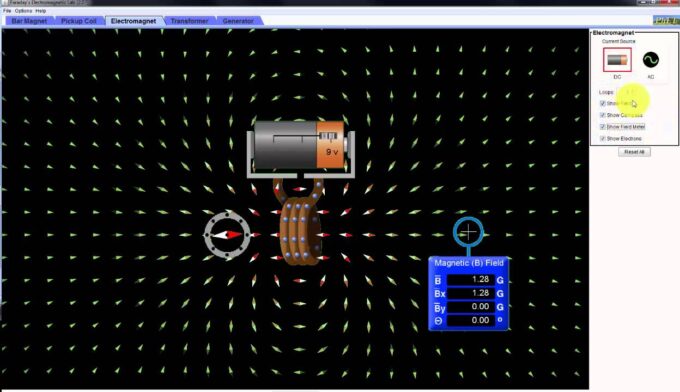Electromagnetism, one of the fundamental branches of physics, is a subject that intertwines the concepts of electricity and magnetism. It plays a crucial role in our understanding of the universe, from the smallest particles to the largest galaxies. Whether you’re a student, a researcher, or just a physics enthusiast, having the right tools and apps can make studying electromagnetism not only easier but also more engaging and fun. In this article, we’ll explore some of the best resources available to help you dive deep into the world of electromagnetism.
When grappling with the complexities of electromagnetism, it can be immensely beneficial to refer to comprehensive resources that provide a plethora of solved problems in electromagnetism. These resources offer practical examples and step-by-step solutions, making it easier to understand intricate concepts and apply them to real-world situations.
Interactive Simulations

Source: youtube.com
Interactive simulations are an excellent way to visualize and understand the principles of electromagnetism. These tools allow you to manipulate variables and see the effects in real-time, providing a hands-on learning experience. One standout resource is PhET Interactive Simulations, developed by the University of Colorado Boulder. PhET offers a range of simulations covering various topics in electromagnetism, such as electric fields, circuits, and magnetic forces. These simulations are not only visually appealing but also scientifically accurate, making them a valuable tool for both students and educators.
Educational Apps
In today’s digital age, mobile apps have become an integral part of the learning experience. There are several apps specifically designed to help students grasp the concepts of electromagnetism. One such app is “ElectroDroid,” which is available for both Android and iOS devices. ElectroDroid is a powerful electronics reference and calculator app that provides a wide range of tools and resources for studying electromagnetism. It includes calculators for Ohm’s Law, reactance, voltage dividers, and more. Additionally, ElectroDroid offers a comprehensive collection of pinouts for various connectors and components, making it an invaluable tool for anyone working with electronics.
Online Courses and Lectures

Source: emworks.com
Online courses and lectures are a great way to learn electromagnetism at your own pace. Many prestigious universities and institutions offer free or affordable courses on platforms like Coursera, edX, and Udemy. One highly recommended course is “Introduction to Electromagnetism” by MIT OpenCourseWare. This course provides comprehensive coverage of electromagnetism, from the basics to more advanced topics. It includes video lectures, lecture notes, and problem sets with solutions, making it a complete learning package.
Another excellent resource is “Fundamentals of Physics II” by Yale University, available on Coursera. Taught by Professor Ramamurti Shankar, this course delves into electromagnetism and its applications. Professor Shankar’s engaging teaching style and clear explanations make complex topics more accessible and enjoyable to learn. The course includes video lectures, quizzes, and assignments, providing a well-rounded learning experience.
For those looking for more specialized content, “Electromagnetic Waves and Optical Physics” by the University of Tokyo on edX is a fantastic option. This course explores the principles of electromagnetic waves and their applications in optical physics. It covers topics such as wave propagation, reflection and refraction, and the behavior of light in different media. With its focus on both theoretical and practical aspects, this course is ideal for students and researchers interested in the intersection of electromagnetism and optics.
Textbooks and Reference Books

book stack and laptop on desk in library. e-book digital technology and e-learning class concept.
While digital tools and online resources are incredibly useful, traditional textbooks and reference books remain essential for studying electromagnetism. These books provide in-depth explanations, detailed derivations, and numerous examples that help build a solid understanding of the subject. One of the most widely used textbooks is “Introduction to Electrodynamics” by David J. Griffiths. This book is known for its clear and concise writing style, making it accessible to students at all levels. It covers a wide range of topics, from electrostatics to electromagnetic waves, and includes numerous problems and exercises to reinforce key concepts.
For those interested in the practical applications of electromagnetism, “Engineering Electromagnetics” by William H. Hayt and John A. Buck is an excellent choice. This book focuses on the engineering aspects of electromagnetism, covering topics such as transmission lines, waveguides, and antennas. It includes numerous real-world examples and practical problems, making it a valuable resource for engineering students and professionals.
Problem-Solving Resources
Problem-solving is a crucial part of mastering electromagnetism. It helps reinforce theoretical concepts and develop critical thinking skills. One effective way to practice problem-solving is by using resources that provide a wide range of solved problems in electromagnetism. Websites like Quisir Solve offer extensive collections of solved problems, covering various topics in electromagnetism. These problems come with detailed solutions and explanations, making it easier to understand the underlying principles and techniques.
Simulation Software
Simulation software allows you to model and analyze complex electromagnetic systems, providing valuable insights into their behavior. One popular software package is COMSOL Multiphysics, which offers a comprehensive suite of tools for simulating and analyzing electromagnetic phenomena. COMSOL allows you to create detailed models of electromagnetic systems, perform simulations, and visualize the results in 3D. It also includes a wide range of pre-built models and tutorials, making it easier to get started.
Another powerful simulation software is ANSYS HFSS, which is widely used in the field of electromagnetic engineering. HFSS allows you to simulate high-frequency electromagnetic fields and analyze their behavior in complex structures. It is particularly useful for designing and optimizing antennas, microwave circuits, and other high-frequency components. With its advanced simulation capabilities and user-friendly interface, HFSS is a valuable tool for researchers and engineers working in the field of electromagnetism.
Online Communities and Forums

Source: teachfloor.com
Online communities and forums provide a platform for students, educators, and enthusiasts to share knowledge, ask questions, and discuss topics related to electromagnetism. These communities can be a valuable resource for finding answers to specific questions, getting help with difficult concepts, and connecting with others who share your interests. One popular online community is Physics Stack Exchange, a Q&A site for physicists and physics enthusiasts. The site features a wide range of questions and answers on electromagnetism, covering both theoretical and practical aspects. With its active and knowledgeable community, Physics Stack Exchange is a great place to seek help and share knowledge.
For those looking for more specialized communities, the Electromagnetics Forum on Edaboard is an excellent option. This forum focuses specifically on topics related to electromagnetics and provides a platform for discussing a wide range of issues, from theoretical concepts to practical applications. The forum features a mix of technical discussions, tutorials, and project showcases, making it a valuable resource for anyone interested in electromagnetis



![Types of Artificial Intelligence Algorithms You Should Know [A Complete Guide] Types of Artificial Intelligence Algorithms You Should Know [A Complete Guide]](https://galeon1.com/wp-content/uploads/2022/11/artificial-intelligence-algorithms-211x150.jpg)



